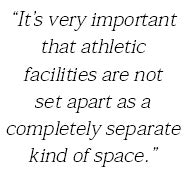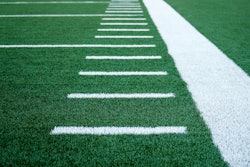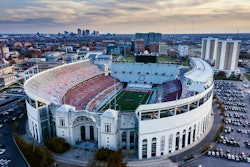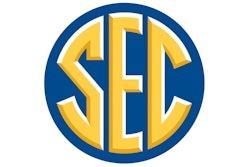Parks and schools team up to create more-natural environments.

While nurturing a rising movement to build habitats on school grounds, Blanchie Carter Discovery Park in Southern Pines, N.C., is also a community park that focuses on its natural roots. More and more parks and recreation departments are seeking ways to reconnect people with nature, while maintaining the services they have always provided. Meanwhile, schools are seeking-and often creating-natural environments to enhance education and creativity.
Carter Park fills both needs by tightly meshing its recreational components with the larger natural landscape, a tactic that is generally missing in today's park planning, says Robin Moore, the park's designer.
"It's either maintain a naturalistic, informal park or bulldoze it for sports facilities, but nothing much in between," says Moore, an urban planner and professor of landscape architecture at North Carolina State University.
"This would be much more of a concept of a community park, where you're providing a whole range of options for different groups in the community." The four-acre park offers habitats such as a cattail marsh, meadow, longleaf pine forest, and a waterway with waterfalls and a pond. Plus, by using native plantings and informal pathways around the turf field, recreational track and playground equipment, the park makes its recreational components appear a part of the scenery.
"We've tried to make it interesting for runners by having a good amount of plantings around the track," says Moore. "The manufactured play equipment is surrounded by trees, shrubs and flowering plants. It feels like it's within a wooded area, or it will in a couple of years when the trees have grown." Adjacent to an elementary school, the park is one of more than 900 areas that have been certified in the National Wildlife Federation's Schoolyard Habitats program since 1995. A number of other organizations also sustain the movement, part of a growing awareness that children thrive best in environments that provide variety and stimulate their imagination.
"It's very important that athletic facilities are not set apart as a completely separate kind of space, but are integrated into the whole so that kids feel like they're in a space that has all kinds of possibilities," says Moore. "It is important to convey the implicit message that these are all different aspects of a young person's life."
The schoolyard movement provides a perfect opportunity for partnerships. At Carter Park, the turf field-featuring the same kind of grass system used by the NFL's Carolina Panthers - is used by schoolchildren as well as the community's organized soccer leagues. Children walk on the track during snack time, and teachers and others can be found there winding down after work with a walk or jog. Children crowd the playground equipment at recess, and return with their grandparents on weekends. And of course, the natural areas are useful to both the school and community for environmental education and passive recreation.
"There are a lot of advantages in the joint use of this kind of open space," says Moore. "Most schools are only in session less than half the time, if you take out holiday periods, summer, weekends and time after school. You can have the parks and recreation department running after-school programs or summer camps."
Carter Park attests to the value of partnerships. After the city made a $25,000 contribution, the park's plan was altered to accommodate children ages 5 to 12, rather than just the K-3 grade levels that would have been accommodated by the school. The park even has its own support group-Friends of Carter Park. Led by president Bruce Cunningham, the group ensures that the park gets the best equipment possible, and by doing so, has brought in even more assistance. The Goodwill Foundation, for example, was going to turn down the park's request for a grant. But when the head of the foundation saw the quality of the facility, he decided to donate $10,000. A continent away, these partnerships are also taking place in Portland, Ore., where Delta Park, the largest athletic complex in Portland, integrates natural elements with facilities for soccer, volleyball, softball, golf and more. Through the parks and recreation department's ongoing facility-use agreement with the city schools, the department's after-school programs use the school facilities, while the schools can use the parks anytime for field trips or environmental education.
But the department's main goal is for families to use the parks together. "We try to create a place that brings out more than just a child. We want the family to be together and play together," says Charles Jordan, Portland's parks and recreation director. "When you have a place that's only softball complexes, you're only going to bring in softball players. That's not the richness that you want."
At the same time, Jordan admits to having occasional difficulties incorporatincorporating natural elements with recreational components. Community members sometimes complain that natural areas will bring in more bugs and wildlife, or may not be as safe for unwary children. "It's a challenge," he says. "Four years ago, I suggested a wetland in a neighborhood park, and let me tell you, citizens weren't excited about that."
In Gresham, just east of Portland, wildlife and environmental issues are causing city officials to rethink the city's main park. Along with a volcanic lava dome and a regional trail system, the park features Johnson Creek, a 26-mile watershed that is home to endangered coho and chinook salmon, as well as stonehead trout. The creek also serves as a migratory path for elk, deer and beaver, and has attracted cougar, bear and other wildlife. Right now, oil from the parking lots adjacent to the creek and pesticides from the ball fields in the creek's floodplain may be contaminating the system. A new master plan would move these elements away from the creek, or to other parks in the city.
"We're certainly not going to remove recreational components from the city," says Ric Catron, a park planner in Gresham. "We're just going to reshuffle the plan. There will still be playing fields in the park, but they will be along the perimeter." The master plan could also call for an outdoor basketball court, horseshoe pits, an amphitheater, a community center and other recreational components. While they would have to be incorporated into areas farther away from the watershed, they could still be incorporated into the overall landscape. The new plan would allow people to better appreciate the natural components of the park-some individuals do not even realize a creek exists within the park-while still enjoying a natural setting for recreational activities. It is an ideal solution, especially as communities see parks more and more as an aid in reconnecting with nature, enhancing health and dealing with teenage violence.
"Parks and recreation have been perceived for many years as just fun and games," says Jordan. "It's just in the past five or six years that we've been able to get the message out that we are also in the business of environmental stewardship, health and wellness, economic development, self-esteem building and education."




































